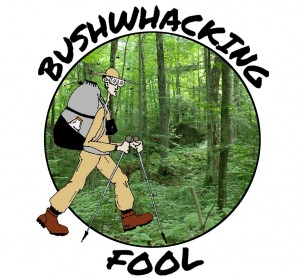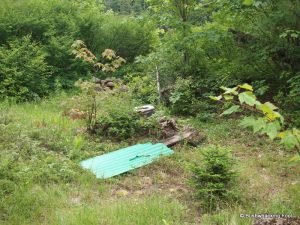
Negro Lake cabin site
Bushwhacking all the way from lower Higby Twin Pond to Negro Lake’s old cabin site in the Five Ponds Wilderness constituted a long day, despite getting there by half-past noon. Following the old road north of the lake allowed for making good time and eventually led me to the peninsula where the old cabin site should be located. That gives me about a half day to burn as I await the forecast heavy rain to come sometime this afternoon. With the cabin site to explore and a campsite to find and set-up for the night, not to mention the surrounding nature to appreciate, it should not be too difficult a task. Hopefully, I can fit this all in before the rain arrives too.
When I reach the top of the ridge on the peninsula, I decide to drop my backpack, shut off the video camera and do a quick survey of the area. West along the ridge, toward the end of the peninsula is likely the location of the old cabin site, so I start there first. As I climb back along the ridge, many downed young conifer trees impose obstacles for me to get around. My legs, exhausted from the long day of hiking, protest but do as they are told.
Twigs and small logs litter the ground here, with much denser conifers and hardwoods blocking my path toward the end of the peninsula. Some flat wooden boards capture my attention, appearing like the remains of an old outhouse as I draw closer. A piece of rusted metal leans against a nearby tree, apparently more remains from the cabin that once stood near this location.
Section Stats:
Date: June 27, 2015
Length: 1.5 miles (8.9 total daily miles; 21.3 total trip miles)
Difficulty: Easy
Two of the outhouse walls remain attached to each other, half submerged within the hole they once stood over. Another side of the privy lies on the ground nearby, the inside wall staring up at the above canopy, accumulated woody debris obscuring much of it. The fourth wall, roof and floor remain missing in action, perhaps put to the torch many years ago.
The wreckage does not hold my attention for long though, as I turn to the dense woody vegetation to the south, where I’m certain the cabin once stood. I navigate around the vegetation to the west and find a path through the new growth without expending too much effort.
As I approach a small clearing, I notice a cement and rock pier, about knee high, that once served as the foundation for the cabin. When I enter the clearing, several other piers are visible within the grass covering the ground, a few near the edge of the new conifer growth, while others are in the middle of the clearing, each with taller herbaceous vegetation growing around their edges. A couple piers remain hidden beneath some of the surrounding trees, the new growth attempting to obscure the human impact as best it can.
An old stack of cut wood is in the middle of the clearing, with a piece of green corrugated plastic lying on the ground nearby, most likely the missing roof of the outhouse. An old toilet seat, apparently salvaged from the outhouse, sits on another pier near the plastic. Underneath the toilet seat are a few rusted metal grills, just where any rational person would store something that comes in contact with food. A thick, but short snag, stands overlooking the entire clearing, just a short distance off into the surrounding growth.
Picking up the green plastic, I find a ring-necked snake coiled up underneath it. A snake skin, either from this individual or another, lies in another corner of the plastic. After a short period of observation, I carefully replace the plastic in its original position, so as not to further disturb the startled reptile. I can only imagine how it must feel, having never had a giant lift off my roof while I was watching television before.
Nearby, at the edge of some shrubby vegetation is the remains of an old fireplace. It, like the piers surrounding it, appears to be made of cemented rocks, probably picked up from the surrounding area. It does not look like it has seen a fire in many days. Back in its prime, the shrubs were likely not present, giving those huddled around the fireplace a beautiful view of the surrounding open water.
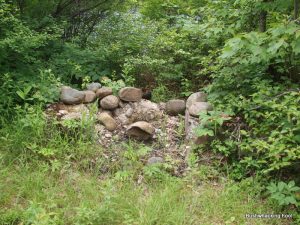
Fireplace
A short trail near the fireplace appears to go down to the Negro Lake shoreline, so I explore it further, anticipating glimpsing a semblance of the view once enjoyed at this site long ago. After pushing myself through the low shrubs, I arrive at a small rocky beach with an expansive view of the lake to the west. The dark accumulating clouds and the realization that I hiked nearly the entire length this morning, plus much more, makes me suddenly tried, thus adding a new urgency to my search for a campsite.
But first, I need to capture some of the beauty of this old site on video. Returning to my poor abandoned backpack at the top of the ridge, I retrieve both my backpack and my video camera. Now with my video camera running, I plan on recreating my recent visit to the cabin site. However, before heading down to the old cabin site, I decide to explore the eastern end of the ridge first to see if there is anything of note located there.
Hiking east along the ridge, I find a small, moss-covered area overlooking the lake. It is mostly devoid of vascular plant life, so I ponder making my campsite here, but it might be too small and too close (although upslope) to the shoreline. As I continue east, the ridge descends nearly to water level, where it provides a nice view of Negro Lake to the east.
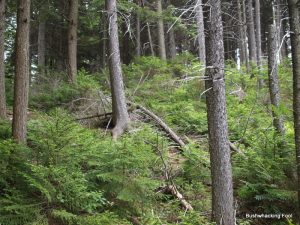
Ridge near cabin site
Gray clouds hang over the open water, with a few wisps of darker clouds interspersed among them. I take a few photos before turning around and heading west toward the end of the peninsula, and the old cabin site. As I climb back onto the ridge and approach its western end, I once again must navigate through the many downed young conifer trees, still proving to be as formidable obstacles as they were earlier on my first time through.
I reenact my previous survey with the video camera running, once again visiting the old outhouse, the cabin clearing and the Negro Lake shoreline just as before. Much of it plays out as it did just a short time earlier; except this time there is a garter snake under the green plastic, instead of a ring-necked snake. Either the snake mastered the art of species transformation, or the two of them did a quick switcharooney on me when I was otherwise occupied.
This time I take a few photographs of the cabin site. When I attempt to get one of the snake under the green plastic, it is long gone. As I start to replace the plastic on the ground, the snake jumps out from between the plastic and the board it is nailed to, slithering away into the grass. Apparently, once your hiding place has been disturbed, it is time to move on and find another one.
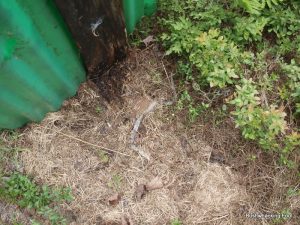
Under plastic
After finishing the photography, I start looking at the clearing as a possible camping site. It is in the open, thus exposed to the forecast heavy rain, and close to the lake too. Despite those flaws, the major disqualifying characteristic is the number of low spots it has; these areas will surely pool water in a torrential downpour, which is a disaster for my poor tarp. I decide to search for a better location into the surrounding forest instead, where I can benefit from the tree cover and the likelihood of finding a low ridge to locate my tarp on.
Having abandoned the idea of setting my campsite here, I take one of the short trails down to the Negro Lake shoreline for some more photography. The lake’s long expanse to the west shows darker clouds moving my way. The time for securing a campsite, so I can at least flee to the relative dryness of my tarp in the event a heavy rainburst lets loose becomes even more urgent now.
With the foreboding clouds and nasty weather forecast, it is time to stop videoing and focus on finding a campsite for a probable wet night (and maybe next day). Since the old cabin site is unacceptable, my only choice is to search along the higher ridge to the north, farther away from the water’s edge. Hopefully, the surrounding area shall provide a better site, but I have my doubts.
Upon reaching the ridge to the north, I head west along it looking for some area big enough where I can place my tarp, preferably on top of a small rise, so any potential downpours can run off and away from the tarp. I already had one incident where I chose the wrong site and ended up in a pool of water in the middle of a rainy night; never doing that again.
One location on top of the ridge west of the peninsula looks promising, but it is awfully narrow, so I continue, this time heading northeast past the old side road that brought me here. This area proves even less satisfactory, so I head down to the low moss covered ridge adjacent to Negro Lake’s shore for another look. This proves less hospitable than I thought before, as it has way too much of a slope to it.
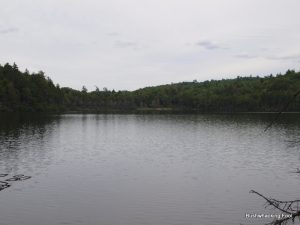
Eastern Negro Lake
After searching up the side road, back toward the main road, I finally decide to head back to the first narrow site west of the peninsula and set up my tarp there. It will not be the best site with the roots sticking out of the ground, but at least it should be dry.
Water filtering, food bag hanging and dinner preparation all follow the tarp set up, with everything done by five in the evening, still without even a lick of rain falling. Rather than head to bed for the night so early, I decide just to enjoy the scenery, but prepare to make a run for the tarp at the slightest indication of a torrential downpour.
A lot of my time is spent near shore at the moss-covered area that I contemplated setting up my camp on before. Although it did not provide the best of views, it did allow for a nice soft place to sit and contemplate the remainder of my hike in the days ahead.
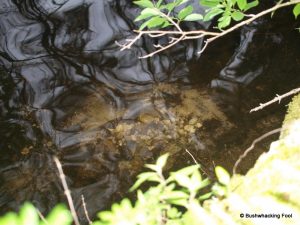
Fish territory
While sitting there, I notice a few small fish hanging around near shore. Two individual fish appear to defend a small area of gravel and sand, chasing away all fish that dare to trespass. This behavior continues consistently for a while, as I sit there wiling away much of my early evening. Occasionally, when I catch a random pestering insect, I toss it in the water and watch the fish scramble for it. Perhaps those defended sites are better for catching these delectable insect snacks.
When not watching the fish, I patrol the area for other wildlife. Although the birds seems to be hunkered down in anticipation of the coming storm, there are a few out and about. Three ducks fly over the lake, but unfortunately, they are gone long before I get a bead on them with my binoculars. Several times I hear a belted kingfisher cackling as it apparently searches for a meal along shore, but it successfully stays out of sight. A common raven caws off in the distance, while golden-crowned kinglets frequently sing from the canopy above. Owl pellets are frequently scattered on the ground too, but despite all the scanning of the upper canopy, I fail to spot any of the night-loving birds.
During one of my patrols, I check underneath the sheet of green plastic at the old cabin site one more time. Again, I find a garter snake underneath, but this individual is different than the previous one, as it is quite a bit larger. Given that its fangs are probably proportionally larger too, I make the decision to leave it be. Smart move on my part.
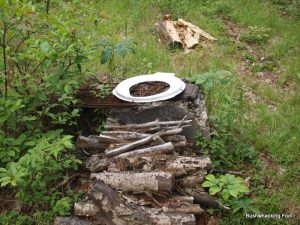
Wood stack & toilet seat
One of my trips sends me down the road toward the direction I most likely will pursue to Wilder Pond, perhaps tomorrow, if weather permits. It is supposed to be a wet few days, so I doubt the trek there will be dry and comfortable, which has pretty much become the theme of this trip.
By about half past seven in the evening, a light rain begins to fall. It slowly picks up intensity as time goes on, but its lightness allows me to stand around and enjoy the experience before retreating to my shelter for the night. The ample coniferous tree cover helps to keep me moderately dry, as I enjoy the calls and antics of a common loon, which makes an appearance as if on cue with the rainfall.
As the rain intensity increases and the clouds become darker, I finally give up and retreat to my shelter for the evening. Once inside, the loudness of the pitter-patter on the tarp makes me thankful that I have such a shelter to escape to, unlike many of my other forest friends. It has been a long day, so after a little note taking, I snuggle up within my sleeping bag for a nice, long, restful sleep.
At least as restful as the predicted heavy rain will allow.
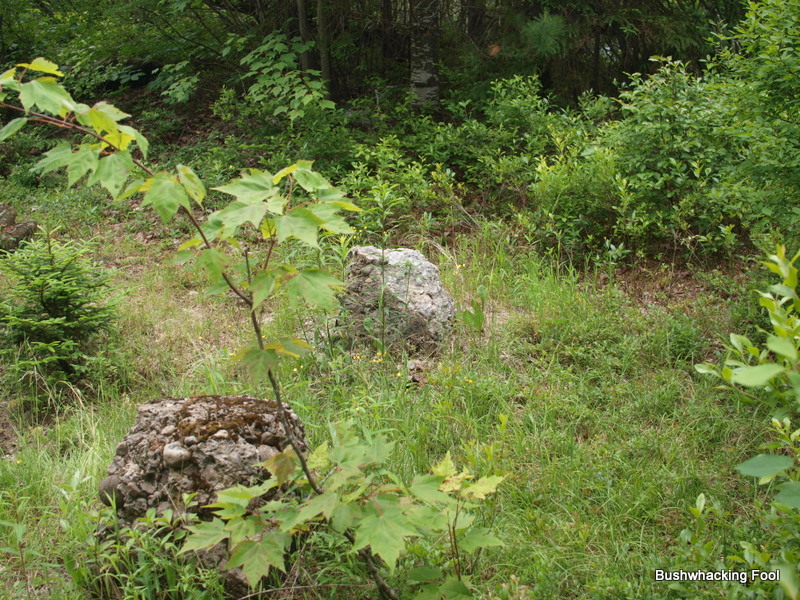
Cabin piers
Affiliate Disclaimer: Some links and advertisements on this blog post and elsewhere on the Bushwhacking Fool may send you to a retailer’s website. If you chose to purchase any product on that site, this author may receive a small commission at no extra cost to you. These commissions provide compensation for the author’s time and effort necessary to provide the content at the Bushwhacking Fool. If you enjoy the content on the Bushwhacking Fool, please show your appreciation by purchasing products through links and advertisements on this site.
